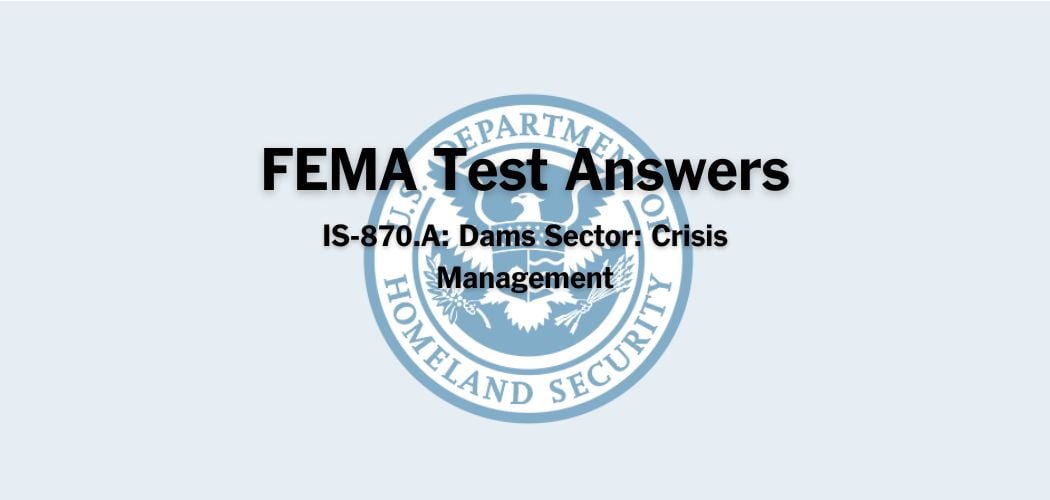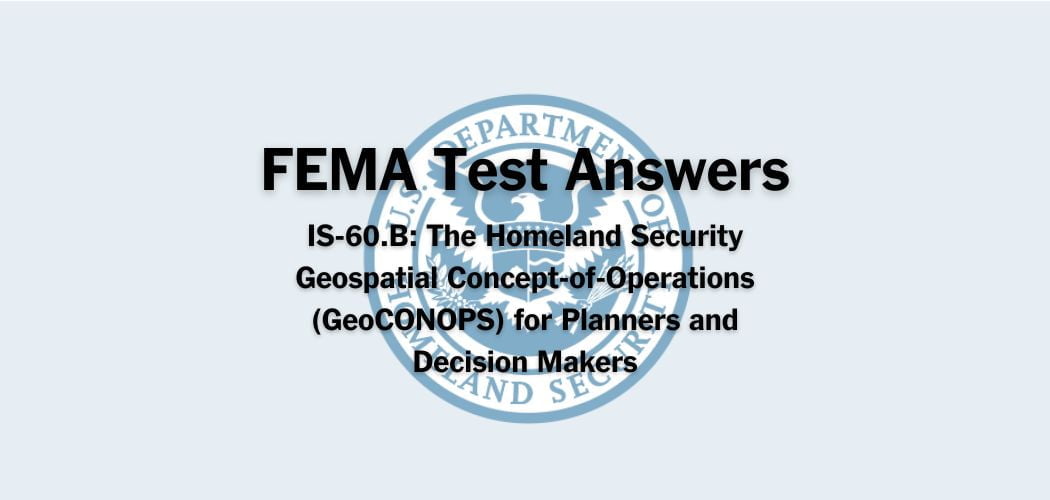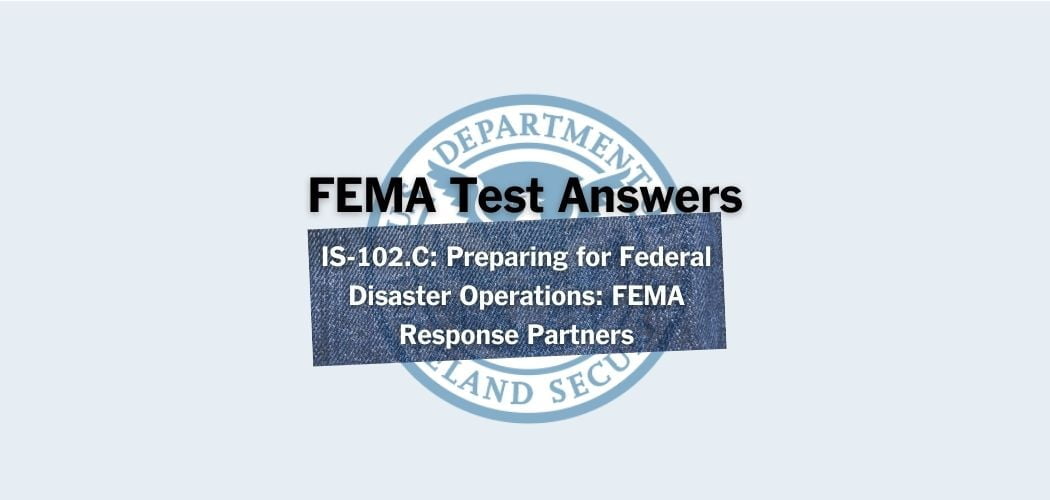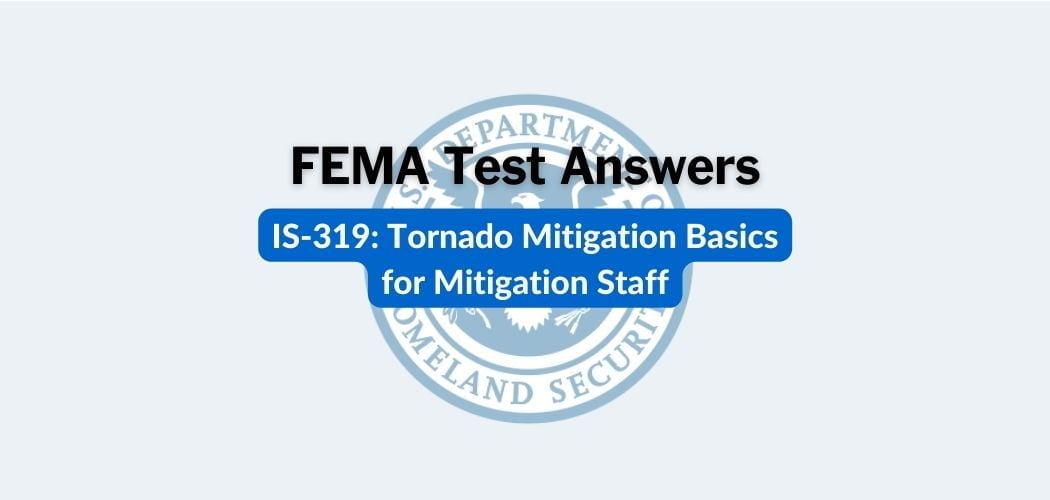Overview: The FEMA IS-350 course was published on 9/3/2021 to provide tribal officials, planners, emergency managers, and other partners with the information necessary to prepare and implement a Tribal hazard mitigation plan. The emphasis is on getting the right people to the table and working through the full planning process.
After attending the FEMA IS-350 course, participants should be able to describe the hazard mitigation planning process and engage community members and know how to identify at-risk community assets and hazards as they relate to risk assessment.
FEMA IS-350 test answers
Each time this test is loaded, you will receive a unique set of questions and answers. The test questions are scrambled to protect the integrity of the exam.
Question 1. The very first meeting of the planning team should focus on:
A. Developing Tribe-specific solutions for the identified risks.
B. Coordinating with FEMA representatives.
C. Identifying mitigation actions.
D. Describing the overall purpose of the plan.✅
Question 2. It is helpful to develop a wide range of solutions to address vulnerabilities. Which solution is relevant to prevent flooding to a tribal asset?
A. Tearing down the structure and rebuilding it the same way.
B. Tenant eviction.
C. Choosing a solution based on cost alone.
D. Elevating the structure in its current location.✅
Question 3. What is the correct order for the hazard mitigation approval process if you are a tribe working directly with FEMA?
A. Submit to FEMA for review; FEMA issues approval letter and final review; FEMA notifies Tribe plan is APA; Tribal council adopts plan and submits resolution.
B. Submit to tribal council for review, FEMA issues approval letter, submit to FEMA for review, tribal council adopts plan, FEMA notifies Tribe plan is APA.
C. Submit to FEMA for review; Submit to State for review; FEMA notifies Tribe plan is APA; Tribal council adopts plan and submits resolution; FEMA issues approval letter.
D. Submit to FEMA for review; FEMA notifies Tribe plan is APA; Tribal council adopts plan and submits resolution; FEMA issues approval letter.✅
Question 4. Which describes a problem statement?
A. Jurisdictional boundaries of a problem?
B. Impact of courses of action.
C. Summarizes a particular vulnerability or problem that is supported by the findings of the risk. assessment✅
D. Statement by stakeholders about the planning team.
Question 5. The optional Approvable Pending Adoption (APA) process is potentially time-saving for communities. What is true about this process?
A. Some jurisdictions seeking plan approval may receive APA after adoption of the plan based on agency priorities.✅
B. APA is a process by which you apply for funding based on the start date of the project.
C. Some jurisdictions seeking plan approval may receive APA after adoption of the plan based on agency workload.
D. APA is a recommended process by which you submit the final draft of the mitigation plan to FEMA for review prior to formal adoption by the Tribal Council or other authorized governing body.
Question 6. On one planning team, members are reluctant to include intergovernmental coordination and prefer to silo their planning efforts. What would NOT be a possible solution to this problem?
A. Expand local capacity for mitigation.
B. Contact FEMA.✅
C. Incentivize mitigation planning.
D. Make Tribal leaders aware of the benefits of integration.
Question 7. Which of the following is a description of qualitative vulnerability analysis?
A. Counts the specific losses to the highest value structures.
B. Discuss quality of risk to a community.
C. Estimate potential fatalities, injuries, direct property loss and damage, and indirect economic loss.
D. Describe the types of impacts that might occur in a hazard event in a narrative.✅
Question 8. What does a well-written summary of vulnerabilities include?
A. A detailed description of the potential impacts of each hazard for each participating jurisdiction in the plan.
B. A general description of the potential impacts of each hazard for each participating jurisdiction in the plan.
C. A list of key issues or problem statements that clearly describes the Tribal government’s greatest vulnerabilities and that will be addressed in the mitigation strategy.✅
D. A detailed list of the total exposure of population, structures, and critical facilities in the Tribal planning area.
Question 9. Identify the secondary hazard and cascading effects of a wildfire when followed by rain.
A. Can include high winds, lightning, and heavy rains
B. Can lead to fires and landslides
C. Can produce mudslides and devastating flooding✅
D. Can include flooding and wind hazards
Question 10. As part of plan maintenance, proposing a congratulatory Tribal resolution or achievement award is an example of:
A. Keeping the non-Tribal public involved in the plan maintenance process.
B. Being accountable to FEMA representatives.
C. Keeping State and FEMA involved in a plan’s maintenance.
D. Maintaining engagement from tribal members and partners in the plan maintenance process.✅
Question 11. Which of the following is the BEST way that planners can help during the implementation phase?
A. Train others to implement the plan.
B. Assist at every step of the implementation of the plan.
C. Coordinate with the FEMA representative to implement the plan.
D. Helping with the permitting process, securing funds, and technical design elements.✅
Question 12. Which of the following is a benefit of plan integration?
A. Minimizes sharing of resources.
B. Addresses the needs of multiple tribes.
C. Complies with state requirements.
D. Supports multiple community objectives.✅
Question 13. Which of the following describes a planning and regulatory capability?
A. The resources that a Tribe has access to or is eligible to use to fund mitigation actions.
B. Methods to implement mitigation activities and communicate hazard-related information.
C. Staff and staff’s skills, that communities have.
D. Laws, land use plans, building codes, ordinances, and plans in place to guide physical development on tribal land.✅
Question 14. What is true about scenario analysis?
A. Usually helpful for low-frequency, high-consequence events.
B. Usually helpful for high-frequency, low-consequence events.
C. Doesn’t incorporate monetary costs, casualties, downtime, damage, etc.
D. Can be used to describe possible impacts if different growth and development events were to take place.??✅
Question 15. Which of the following is a distinguishing feature of mitigation actions?
A. Address actions that reduce risk to existing development ONLY.
B. Mitigate the need for risk assessment.
C. Address actions that reduce risk to future development ONLY.
D. Address specific problems that connect to issues identified in the Risk Assessment.✅
Question 16. What type of hazard might include an avalanche, drought, earthquake, epidemic, flood, or hurricane?
A. Human-caused
B. Power grid
C. Technological
D. Natural✅
Question 17. Impacts are _______.
A. Natural processes that people and communities have little?control over.
B. The effect of a hazard on the Tribe and its assets.✅
C. The characteristics of the hazard no matter when or where it occurs.
D. Based on the community’s ability to mitigate, prepare, respond, and recover from events.?
Question 18. Which of the following is a reliable source of hazard information?
A. Review existing studies, reports, and plans related to flooding, wildfire, geological, and other hazards.✅
B. Compare and contrast hazard information from many different communities
C. Review the hazard mitigation plans of distant jurisdictions.
D. Do an internet search for hazard information.
Question 19. Which of the following is a tip for involving the public?
A. Involve the public to circumvent resistance to plan implementation.
B. Conduct outreach when you don’t have enough members for your planning team.
C. Identify what type of input you need from partners and the public, and when you will ask for that input.✅
D. Involve the public at the end when you have a draft written.
Question 20. At the beginning of the planning process, identify ONE task that the planning team needs to complete.
A. Identify hazards for each participating community
B. Plan a risk assessment
C. Determine plan scope and schedule✅
D. Estimate losses for vulnerable properties
Question 21. Which of the following BEST describes the role of the planning team when evaluating as part of plan maintenance?
A. The planning team reviews the mitigation plan and prepared a report for their governing bodies that demonstrates progress.✅
B. The planning team acts as a liaison to government entities.
C. The planning team delegates tracking plan implementation to a contractor.
D. The planning team looks for ways to expand the reach of the plan.
Question 22. What is true about a Tribal Hazard Mitigation Plan?
A. EPA delegates the authority to approve plans.
B. Not recognized by FEMA
C. The plan document is more important than the planning process.
D. The mitigation plan belongs to your Tribal community and works with your history, culture, governance, and partners.✅
Question 23. Tribes must develop a method and schedule for updating the plan on a 5-year cycle. What is an important reason to do this?
A. Reevaluate priorities based on newly elected officials.
B. Reevaluate priorities based on additional stakeholders.
C. Update contact information.
D. Identify any elements and processes that will be changed in the updated plan.✅
Question 24. What is the purpose of the capability assessment?
A. Helps identify where there are gaps that you could fill through the planning process.
B. Helps identify what impacts will result in loss.
C. Helps identify what risks will result in loss.
D. Helps identify what resources are currently available, and where there might be gaps.✅
Question 25. A Community Wildfire Protection Plan, as defined by the Healthy Forest Restoration Act, identifies a community’s priorities for wildfire fuel-reduction projects. When a tribe already has a CWPP, this is best described as an example of linking Tribal efforts by _______.
A. Creating conflicting goals for hazards.
B. Using the risk assessment to motivate Tribal efforts.
C. Using the risk assessment to inform plans and policies.
D. Implementing mitigation actions through existing mechanisms and capabilities.✅
Question 26. 44 CFR Section 201.7 and the Tribal Mitigation Plan Review Guide advises that _______.
A. Non-federally recognized Tribal governments with a FEMA-approved mitigation plan may NOT apply for assistance through their SHMO if their mitigation plan was coordinated with the State.
B. Non-federally recognized Tribal governments with a FEMA-approved mitigation plan may apply for assistance directly to FEMA.
C. Federally recognized Tribal governments do not need a FEMA-approved mitigation plan to apply for FEMA Hazard Mitigation Assistance Grants (HMA) project grants.
D. Tribal governments are required to have a FEMA-approved mitigation plan to apply for FEMA Hazard Mitigation Assistance (HMA) planning grants.✅
Question 27. Risk assessment findings are _______
A. Direction of other community plans.
B. Broader-based statements for reducing risk and allocating resources.✅
C. Theme that stood out during planning team meetings.
D. Conclusions contained in the problem statements.
Question 28. Which large-scale risk assessment approach uses data or reports and models to quantify changes in probability?
A. Down-scaled data projections
B. Historical analysis
C. Regional✅
D. Qualitative
Question 29. When should a tribe use the historical analysis approach?
A. In an oral history.
B. During cultural events.
C. When changes in future conditions are known.
D. It may be appropriate for events that occur relatively frequently in the planning area.✅
Question 30. Which risk assessment approach can be generalized with descriptions based on Tribal knowledge?
A. Down-scaled data projections
B. Historical analysis
C. Regional
D. Qualitative✅
Question 31. Which of the following is the BEST way to keep Tribal members and partners involved?
A. Have FEMA speakers come to inform stakeholders.
B. Conduct stakeholder meetings every three years to monitor, update, and evaluate the HMP.
C. Communicate often with the Tribal community✅
D. Conduct stakeholder meetings every five years to monitor, update, and evaluate the HMP.
Question 32. Which of the following should not be considered when prioritizing mitigation actions?
A. Whether the project looks nice.✅
B. Support for Tribal Objectives.
C. Project Cost or Other Economic Factors.
D. Administrative/Technical Assistance.
Question 33. When a tribe is tracking the plan’s overall progress towards implementation, it is being _________
A. Updated.
B. Mitigated.
C. Evaluated.
D. Monitored.✅
Question 34. Which of the following is a reason to engage the public in the planning process?
A. Community members can be asked to write the plan
B. Eliminate community pushback
C. It strengthens your plan by reflecting the Tribes values, experience, history, culture, and input✅
D. It guarantees compliance
Question 35. Which of the following is true about historical analysis?
A. It may still be appropriate for events that occur relatively infrequently in the planning area.
B. It is most useful for hazards that are culturally related.
C. ?It uses current data to predict future trends.
D. It uses information on impacts and losses from previous hazard events to predict potential impacts and losses in a similar type of future event.✅
Question 36. What is true about assessing Tribal capabilities?
A. It must be limited to mitigation-specific capabilities.
B. FEMA requires tribes to follow a certain format.
C. Recommendations for resource use are included from FEMA.
D. Reviewing capabilities helps identify resources available to reduce losses and gaps to fill.✅
Question 37. Planning team members need to have expertise in _______
A. Hazards and disaster history✅
B. Working with FEMA
C. FEMA processes
D. Social media tools relevant to plan functions
Question 38. Part of examining community support is assessing which ONE of the following?
A. Hazards
B. Risks
C. The community’s comprehensive plans, if applicable✅
D. Community resources
Question 39. What is a source of harm or difficulty created by a meteorological, environmental, or geological event?
A. Vulnerability
B. Impact
C. Community asset
D. Hazard✅
Question 40. Capabilities may include laws, regulations, policies, programs, staff, funding, or cooperative agreements. They should be specific to:
A. Seasonal changes.
B. Capabilities your Tribe has that help make the planning area more resilient.✅
C. Environmental Protection Agency regulations.
D. Pre-disaster policies only.
Question 41. For multi-jurisdictional planning efforts, the risk assessment must result in an evaluation of potential impacts and issues of concern for each participating jurisdiction to use in developing mitigation actions specific to _______.
A. Each Hazard.
B. Each Impact.
C. Each Risk.
D. Each Jurisdiction.✅
Question 42. Which of the following is a purpose of a hazard mitigation plan?
A. Win public funding
B. Compel public opinion through media
C. Earn political support from elected officials
D. Identify policies and actions that can be implemented over the long term to reduce risk.✅
Question 43. Following a disaster, there is generally a great deal of public interest in mitigation. This provides an opportunity for especially what type of planning?
A. Environmental protection planning.
B. Land use planning.
C. Fiscal conservation planning.
D. Redevelopment with mitigation and recovery in mind.✅
Question 44. A planning team is describing their planning area. What should they include in the process?
A. Describe the seasonal climatic differences that occur in the land area
B. Only reservation lands
C. Disregard multijurisdictional boundaries
D. Describe any land your Tribe maintains outside the reservation boundaries✅
Question 45. Which of the following is the BEST example of how to link Tribal mitigation efforts to other plans?
A. Update the names of tribal elders in the plan revision.
B. Require attendance of Tribal elders at public meetings.
C. Incorporate the results of the risk assessment into the other plans to guide investments away from unsafe areas.✅
D. Promote Tribal implementation efforts on social media.
Question 46. Which of the following is an appropriate question to ask during exposure analysis?
A. What is the total loss value in the hazard-prone areas?
B. What economic impacts may occur in the planning area?
C. How many critical facilities are located in the hazard area and what is their value?
D. What impacts have severe weather storms had on the planning area?✅
Question 47. What is true about plan adoption?
A. Must take place within 6 years of receiving approvable-pending-adoption status.
B. Must take place within 3 years of receiving approvable-pending-adoption status.
C. Can be by resolution, executive order, a notice of action, or another format.✅
D. May be eligible for certain FEMA assistance before adoption if plan progress can be documented.
Question 48. Which of the following statements is TRUE about plan updates and monitoring?
A. Review and analyze a different community’s method and schedule for monitoring and updating the plan.
B. Plan updates are only necessary if required by senior leaders.
C. Having a process in place for monitoring will keep the planning team ‘in the know’ for preparing for the next plan update.✅
D. Predict the planning team members for the next update process.
Question 49. When a plan is being reviewed to see how it is meeting the stated vulnerabilities, capabilities, and mitigation goals, it is being _______
A. Updated.
B. Analyzed.
C. Evaluated.✅
D. Monitored.
Question 50. Why estimate future losses?
A. To understand the economic impact of hazard events✅
B. Answers the likelihood of future hazard events
C. To identify only man-made hazards.
D. It builds public trust
Question 51. Which of the following is a consideration for updating a risk assessment?
A. Changes in stakeholders’ availability.
B. Changes in the number of hazard occurrences.✅
C. Changes in the value of community assets.
D. Death of leadership.
Question 52. Which of the following would be considered post-disaster capabilities?
A. Long-term recovery plans, policies, and procedures.✅
B. Building codes
C. Floodplain Management ordinances
D. Natural or cultural resource conservation plans,
Question 53. What term would be used to describe the depth of a flood?
A. Previous occurrence
B. Probability of future events
C. Impact
D. Extent✅
Question 54. Vulnerability analysis involves asking “what if”? What is one way to do this?
A. Look at historic events to see what impacts and losses were caused.
B. Conduct exposure analysis to quantify levels of existing risk.
C. Using maps, make a list of assets in harm’s way.
D. Use hypothetical scenarios to describe impacts.✅
Question 55. Which of the following statements BEST describes the purpose of regularly evaluating the plan?
A. It keeps the community informed of the plan’s status and progress in mitigation efforts.✅
B. It can trigger updates of all other plans, if necessary.
C. It provides additional funding for mitigation actions.
D. It guarantees that any new ordinances correspond to identified mitigation actions.
Question 56. What kind of mitigation action is installing a safe room?
A. Natural systems protection.
B. Education and awareness.
C. Structure and Infrastructure project.✅
D. Tribal plans and regulations.
Question 57. When building your planning team, ideally the team will reflect which ONE of the following?
A. Able to handle disgruntled community members
B. Political connections
C. Training in hazard mitigation
D. Organizations with the expertise and authority to implement the mitigation strategy✅
Question 58. Which ONE of the following is a reason why mitigation plans must be updated and resubmitted?
A. New elected officials.
B. Improve risk assessment and demonstrate progress in risk reduction.✅
C. New media channels.
D. New stakeholders.



